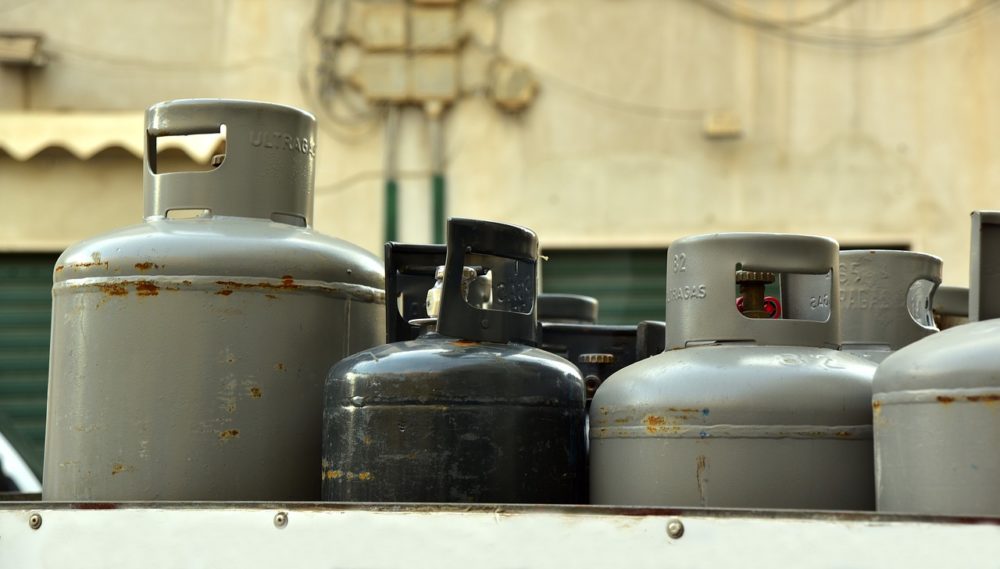So, you’re asking yourself this question: “What size propane tank do I need for my house?” — and this article will answer it for you!
You’ve weighed the pros and cons of natural gas vs. propane as the heat source for your home and determined that propane will work best for your needs. Great news! Propane is a versatile fuel source that has many uses. This includes home heating, producing fire, cooking, and cleaning, making it an essential part of a home or commercial establishment.
Not to mention, the environmental advantages of propane gas make this an especially good fuel choice that also offers cost savings, so you can rest assured you’re helping the environment and your wallet!
But now, back to the question you need to answer: What size propane tank do I need for my house?
Propane is available economically and efficiently all year long and is quickly and safely stored in propane storage tanks in various sizes on your property. Depending on the tank size, they’re placed at least three feet away from your house. Choosing the right size propane tank, therefore, is a crucial decision.
What Size Propane Tank Do I Need for My House: Why the Right Answer Matters
The biggest reason this decision is so important? Notably, it can cost you money if you’ve chosen a propane tank size that is inappropriate for your home.
If your propane tank is too small, it will need filling more often. When you get propane delivered to your home, you pay for the propane, and of course, for the delivery. The more times you have to get the propane delivered, the more delivery fees you pay. Also, propane companies often provide the fuel at a higher rate when delivering smaller quantities, so with a smaller tank, you can even pay more for the gas itself.
So why not just buy a big tank in the first place and not have to deal with this problem? You could. However, you will pay more upfront for the cost of the tank and installation, so it’s best to take a few minutes to ensure you get the right-sized propane tank in the first place and save money all around!
Also, remember that the bigger the tank, the stricter the local safety and installation regulations may be.
While it may seem like it’s a hard mistake to make, you’d be surprised. Countless homes across Arizona and the country have the wrong size propane tank.
What Propane Tank Sizes are Available?
Before we dive into determining the size of propane tank you need specifically, let’s look at the different tank sizes that propane can come in.
Propane tank sizes can confuse people because sometimes they reference the volume of liquid they hold, and other times they indicate the weight in pounds when full.
Note: Manufacturers always list the two largest tank sizes by gallons, not weight.
It’s also helpful to remember that tanks are filled to a maximum of 80% of their capacity to allow for the natural expansion of liquid propane that occurs with a temperature change. Therefore, a 500-gallon tank typically holds approximately 400 gallons or 1,500 liters of liquid propane.
Common Residential Propane Tank Sizes
Now we’ll review some of the most common propane tank sizes available, from the smallest tanks for portable cooking to the largest for commercial, industrial, and agricultural applications.
-
1lb propane tank
This is a small propane tank used in camping stoves, portable barbecues, etc. You’ll find them at most big box household or hardware stores.
-
20lb/5-gallon propane tank
Most full-sized gas barbeques run off 20-pound propane tanks—they can be refilled or exchanged at many local gas stations.
-
33lb /8-gallon propane tank
People use these tanks to power vehicles like forklifts or farm vehicles. A forklift with a four-cylinder engine can operate for about eight hours on a full 33-pound propane cylinder. It’s unlikely anyone would use this size tank for home heating.
-
100 lb /25-gallon propane tank
This size tank is the lightest of the tanks suitable for homes and is ideal for homes with smaller or few propane appliances, e.g., a gas cooking range or indoor fireplace. The more items in your home fueled by propane—such as water heaters—the more likely you will need a larger propane tank—you risk running out often with a 100-pound propane tank.
-
200 lb /57-gallon propane tank
This is a common size of propane tank in smaller homes. It holds enough propane to run cooking appliances, heat water, and dry clothes. However, it’s limited in that it can only run bigger appliances (again, like water heaters) for a limited duration.
-
420 lb/100-gallon propane tank
You can use these tanks for a variety of commercial as well as residential purposes. If you use propane at home for something other than primary home heating, this tank is for you.
The 100-gallon tank can:
- Run appliances such as a gas cooker
- Heat a swimming pool
- Run a fireplace for a long time
-
500-gallon propane tank
Larger residential homes commonly use this size propane tank as the primary fuel source. People often use it for home heating, powering generators, cooking, pool heating, and more.
One main advantage of this tank size is its longer duration between refills. Additionally, when you buy more gallons of propane, you often receive a slightly lower price rate due to bulk purchasing.
This tank size also suits many commercial buildings because it’s more efficient than smaller tanks. However, they demand more space because the propane is harder to transport at this size, and the tanks are almost 10 feet long. You must also place the tank at least 10 feet from any building or property boundary.
-
1,000-gallon propane tank
For very large homes or for agricultural and commercial businesses, a 1,000-gallon tank will likely be the best choice. It does everything the 500-gallon tank does but can do at a larger scale.
For example:
- Heating homes
- Running multiple appliances
- Heating pools
- Powering generators
This tank is larger than necessary for the average home. Because they span almost 16 feet in length, professionals must install this tank at least 10 feet from any building and 10 feet from any property line.
How is the Right Size of Propane Tank Determined?
There are a number of factors that you have to take into consideration to correctly answer, “What size of propane tank do I need for my house?”
What is the size of your home?
For homes over 2,500 square feet using propane for heating and running multiple appliances, a 500-gallon tank would be the best choice.
If your home exceeds 4,500 square feet, you should choose the 1000-gallon tank, but only if you have enough outdoor space to store it. These tanks are also perfect for heating a smaller home far from the source, reducing the number of fill-ups required throughout the year.
Here’s another post you don’t want to miss next: What to do if you have a propane tank leak.
How many appliances will be running off the propane?
For homes with up to three appliances using propane, a 100-pound tank should fit well. If you only need propane for your gas fireplace, clothes dryer, or stove, this tank is for you!
What size is your family?
The larger your family, the more gas you likely use daily, mainly for water heating. More people means more people taking showers, washing their hands, etc.
What available space do you have to store a propane tank?
Before you buy a tank, measure where you will put it. Above ground, propane tanks are ideal for consumers with a satisfactory place in their yard for installation.
If you have limited space, you might consider installing an underground tank. Designers intend underground tanks to be buried, making them completely invisible except for the dome that covers the valves to service the tank.
Please remember that in both cases of above- or below-ground tanks, codes require all propane tanks filled on site to have a line of sight to the truck providing refill service. Other city codes will also apply, so it’s best to be familiar with these before purchasing a tank.
Where is your home located?
The size of the tank you need may vary based on climate and usage. Homes located in areas difficult to reach for deliveries in the winter may want to consider a larger size for the extra storage it offers. However, this won’t be a consideration in Arizona where winters are not typically as cold as in other parts of the country.
Conclusion: What Size Propane Tank Do I Need for My House?
Propane tanks come in several sizes, each with its own capacity to power homes and commercial buildings. Ultimately, when it comes to the propane tank size you need, the main factors determining the right size for your home propane tank will be the number of appliances running off the propane and the space you have available to store the tank.
Smaller homes with fewer appliances need smaller tanks; larger homes with more appliances and items like heated pools, outdoor fireplaces, etc., will need much larger ones.
A reputable gas piping contractor like RP Gas Piping will evaluate the needs of your property and propose a plan to install or upgrade your propane gas pipe system. This includes an inspection of any existing gas pipelines and a recommendation for storage tank placement that is convenient for both delivery trucks and gas line plumbing to appliances.
Contact us today for an estimate!
Enjoyed this article about home propane tanks?
Here are three more to help you:
- How to Bury a Propane Tank
- Propane vs Natural Gas: Differences and Similarities
- The Right Green Energy Choice: Propane
This article was updated in 2023.


